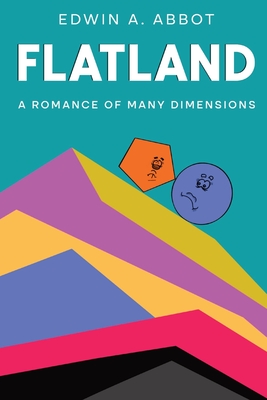182 Results with the "Philosophical" genre
Adventure Fiction (1164)
Biography (435)
Business & Finance (1)
Children's Literature (124)
Comics (6)
Culture (51)
Drama (123)
Dystopian (29)
Fable (86)
Fantasy (1132)
Fantasy (203)
Fiction (1010)
Finance (1)
Gothic Fiction (12)
Historical Fiction (615)
History (122)
Horror (56)
Lifestyle (36)
Literary (404)
Literary Fiction (207)
Memoir (113)
Mystery (422)
Non-fiction (87)
Novel (549)
Paranormal Fiction (96)
Philosophy (45)
Poetry (249)
Political Fiction (14)
Politics (42)
Practical (32)
Psychological (4)
Psychological Thriller (108)
Relationship (6)
Romance Novel (716)
Romantic Melodrama (14)
Satire (91)
Science (46)
Science Fiction (345)
Self-help (68)
Society (65)
Society (2)
Spiritual Growth (1)
story (2)
Thriller (704)
True Crime (56)
view (11)
Women's Fiction (2)
Young Adult (233)
-
 Section 6 delves into the unique way Flatlanders interpret visual information in a world limited by two dimensions. Sight recognition plays an essential role in the lives of the upper classes, particularly in areas where the natural presence of fog assists in the process. In these foggy regions, objects at various distances take on different degrees of dimness. This visual fading creates a gradient effect, allowing trained eyes to discern one shape from another. For instance, the angle of a triangle might…
Section 6 delves into the unique way Flatlanders interpret visual information in a world limited by two dimensions. Sight recognition plays an essential role in the lives of the upper classes, particularly in areas where the natural presence of fog assists in the process. In these foggy regions, objects at various distances take on different degrees of dimness. This visual fading creates a gradient effect, allowing trained eyes to discern one shape from another. For instance, the angle of a triangle might…-
92.9 K • Ongoing
-
-
 Section 5 explores the rigid structure that defines a woman’s place in Flatland—a society where mobility, both social and intellectual, is essentially impossible for them. Women are shaped as mere lines, and this geometric limitation marks them as inherently inferior in the eyes of the system. Unlike other shapes that can evolve into higher forms, women remain fixed, both in form and fate. There is no educational path, no social strategy, and no merit-based system that can change their status. As a…
Section 5 explores the rigid structure that defines a woman’s place in Flatland—a society where mobility, both social and intellectual, is essentially impossible for them. Women are shaped as mere lines, and this geometric limitation marks them as inherently inferior in the eyes of the system. Unlike other shapes that can evolve into higher forms, women remain fixed, both in form and fate. There is no educational path, no social strategy, and no merit-based system that can change their status. As a…-
92.9 K • Ongoing
-
-
Chapter
Section 4: Concerning the Women
 Section 4 presents a disturbing view of societal control in Flatland, particularly how irregular or discontented citizens are dealt with by the ruling Circles. Those who do not meet the strict standards of shape may find themselves confined for life in state institutions under the pretense of rehabilitation. A few of the most rebellious or hopelessly flawed are executed without fanfare, considered a threat to the stability of the realm. To suppress unrest, especially among the Isosceles class, the…
Section 4 presents a disturbing view of societal control in Flatland, particularly how irregular or discontented citizens are dealt with by the ruling Circles. Those who do not meet the strict standards of shape may find themselves confined for life in state institutions under the pretense of rehabilitation. A few of the most rebellious or hopelessly flawed are executed without fanfare, considered a threat to the stability of the realm. To suppress unrest, especially among the Isosceles class, the…-
92.9 K • Ongoing
-
-
 Section 3 explores the social structure of Flatland through both its geometry and strict hierarchy. Buildings in populated areas must follow a legal standard that ensures safety by limiting sharp angles, with pentagonal forms being the lowest acceptable design. This reflects a broader cultural shift, where even architecture mirrors the drive toward symmetry and refinement. Only in remote, undeveloped regions might a square house still be found—an architectural relic seen more as a curiosity than a…
Section 3 explores the social structure of Flatland through both its geometry and strict hierarchy. Buildings in populated areas must follow a legal standard that ensures safety by limiting sharp angles, with pentagonal forms being the lowest acceptable design. This reflects a broader cultural shift, where even architecture mirrors the drive toward symmetry and refinement. Only in remote, undeveloped regions might a square house still be found—an architectural relic seen more as a curiosity than a…-
92.9 K • Ongoing
-
-
 Section 2 introduces the geographical orientation and architectural norms of Flatland, where the inhabitants navigate using a unique sense of direction. Unlike in Spaceland, there are no visible celestial bodies, so determining North cannot rely on stars or sunlight. Instead, nature itself supplies a solution through a subtle but constant attraction toward the South. In milder regions, this pull is barely noticeable, yet it’s sufficient for most people to find their bearings. Rain also always falls from…
Section 2 introduces the geographical orientation and architectural norms of Flatland, where the inhabitants navigate using a unique sense of direction. Unlike in Spaceland, there are no visible celestial bodies, so determining North cannot rely on stars or sunlight. Instead, nature itself supplies a solution through a subtle but constant attraction toward the South. In milder regions, this pull is barely noticeable, yet it’s sufficient for most people to find their bearings. Rain also always falls from…-
92.9 K • Ongoing
-
-
 Section 1 introduces a world unlike ours—Flatland—a place confined entirely to two dimensions. The name is not used by its inhabitants, but it serves to help three-dimensional readers understand the limitations of life in such a plane. Imagine a sheet of paper where geometric shapes—Lines, Triangles, Squares, and more—move freely along the surface. They cannot rise above or sink below it. These figures aren’t drawn or imagined; they are living, thinking beings, each defined by their sides and…
Section 1 introduces a world unlike ours—Flatland—a place confined entirely to two dimensions. The name is not used by its inhabitants, but it serves to help three-dimensional readers understand the limitations of life in such a plane. Imagine a sheet of paper where geometric shapes—Lines, Triangles, Squares, and more—move freely along the surface. They cannot rise above or sink below it. These figures aren’t drawn or imagined; they are living, thinking beings, each defined by their sides and…-
92.9 K • Ongoing
-
-
 Chapter 33 - The Spirit of History presents not just the chronicle of events, but the embodiment of a man whose life became one with his country’s past. Jules Michelet, driven by a profound calling, gave himself to the task of animating the silent echoes of French history. He did not simply record events—he felt them. To him, dusty records were not remnants of forgotten days but voices waiting to be heard again. With each turn of a page, he believed he was uncovering the living breath of a nation. His…
Chapter 33 - The Spirit of History presents not just the chronicle of events, but the embodiment of a man whose life became one with his country’s past. Jules Michelet, driven by a profound calling, gave himself to the task of animating the silent echoes of French history. He did not simply record events—he felt them. To him, dusty records were not remnants of forgotten days but voices waiting to be heard again. With each turn of a page, he believed he was uncovering the living breath of a nation. His…-
151.7 K • Ongoing
-
-
Chapter
Chapter 32 — A Nation in a Hurry
 Chapter 32 - A Nation in a Hurry begins with a telling comparison between American life and that of Europe. Returning home after time abroad, one is immediately struck by the heightened tempo of daily life in the United States. From the bustling activity on the docks to the way people rush their meals, the national obsession with speed is unmistakable. It permeates everything—how business is done, how people talk, even how they relax. The story about steamboat captains placing someone on the safety valve…
Chapter 32 - A Nation in a Hurry begins with a telling comparison between American life and that of Europe. Returning home after time abroad, one is immediately struck by the heightened tempo of daily life in the United States. From the bustling activity on the docks to the way people rush their meals, the national obsession with speed is unmistakable. It permeates everything—how business is done, how people talk, even how they relax. The story about steamboat captains placing someone on the safety valve…-
151.7 K • Ongoing
-
-
Chapter
Chapter 31 — The Modern Aspasia
 Chapter 31 - The Modern Aspasia opens with a portrayal of Paris as a city unlike any other in Europe. It is not simply a collection of landmarks, but a force that draws people in, seduces them, and reshapes their desires. Unlike Bruges or Ghent, which offer stillness and depth, Paris pulses with a kind of magnetism that attracts both the thoughtful and the frivolous alike. Every street corner seems to whisper a new invitation—one to history, to beauty, or to indulgence. It’s a city of paradoxes, where…
Chapter 31 - The Modern Aspasia opens with a portrayal of Paris as a city unlike any other in Europe. It is not simply a collection of landmarks, but a force that draws people in, seduces them, and reshapes their desires. Unlike Bruges or Ghent, which offer stillness and depth, Paris pulses with a kind of magnetism that attracts both the thoughtful and the frivolous alike. Every street corner seems to whisper a new invitation—one to history, to beauty, or to indulgence. It’s a city of paradoxes, where…-
151.7 K • Ongoing
-
-
 Chapter 30 - The Dinner and the Drama opens by highlighting a curious contradiction in American culture—how a nation overflowing with theaters and wealth can still fail to cultivate a robust dramatic tradition. Despite the presence of grand venues and generous patronage, the heart of the theater seems to beat faintly. Plays with lasting value are rare, and foreign works or shallow entertainments often dominate the stage. The transformation of American life, especially in cities like New York, reveals how…
Chapter 30 - The Dinner and the Drama opens by highlighting a curious contradiction in American culture—how a nation overflowing with theaters and wealth can still fail to cultivate a robust dramatic tradition. Despite the presence of grand venues and generous patronage, the heart of the theater seems to beat faintly. Plays with lasting value are rare, and foreign works or shallow entertainments often dominate the stage. The transformation of American life, especially in cities like New York, reveals how…-
151.7 K • Ongoing
-
- Previous 1 … 11 12 13 … 19 Next
